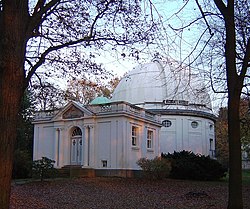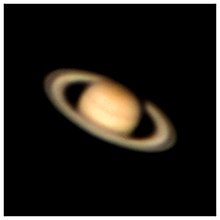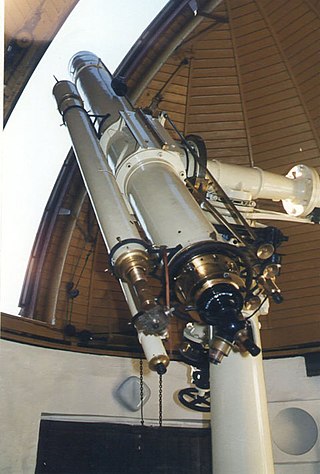
A refracting telescope is a type of optical telescope that uses a lens as its objective to form an image. The refracting telescope design was originally used in spyglasses and astronomical telescopes but is also used for long-focus camera lenses. Although large refracting telescopes were very popular in the second half of the 19th century, for most research purposes, the refracting telescope has been superseded by the reflecting telescope, which allows larger apertures. A refractor's magnification is calculated by dividing the focal length of the objective lens by that of the eyepiece.

The Paris Observatory, a research institution of the Paris Sciences et Lettres University, is the foremost astronomical observatory of France, and one of the largest astronomical centers in the world. Its historic building is on the Left Bank of the Seine in central Paris, but most of the staff work on a satellite campus in Meudon, a suburb southwest of Paris.
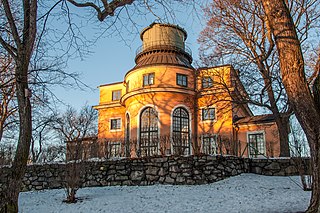
The Stockholm Observatory is an astronomical observatory and institution in Stockholm, Sweden, founded in the 18th century and today part of Stockholm University. In 1931, the new Stockholm Observatory, nicknamed "Saltis", was inaugurated on the Karlsbaderberget at Saltsjöbaden, near Stockholm, and operated until 2001.
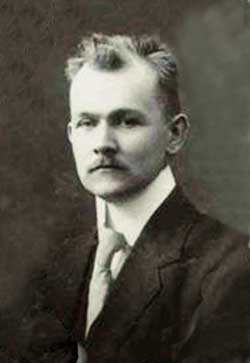
Bernhard Woldemar Schmidt was an Estonian optician. In 1930 he invented the Schmidt telescope, which corrected for the optical errors of spherical aberration, coma, and astigmatism, making possible for the first time the construction of very large, wide-angled reflective cameras of short exposure time for astronomical research.

Johann Georg Repsold was a German manufacturer of scientific instruments, astronomer, and fireman. He began to make astronomic instruments mainly for his own use. His third son Adolf Repsold continued the well-known astronomical instrument firm as the A. & G. Repsold company, which later became A. Repsold und Söhne.
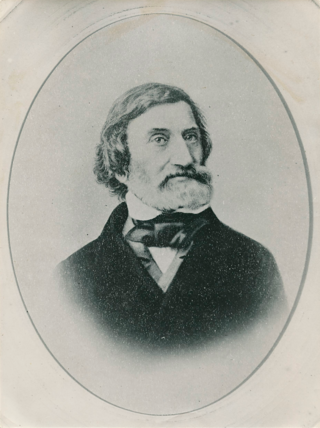
Carl Ludwig Christian Rümker was a German astronomer.

The Berlin Observatory is a German astronomical institution with a series of observatories and related organizations in and around the city of Berlin in Germany, starting from the 18th century. It has its origins in 1700 when Gottfried Leibniz initiated the "Brandenburg Society of Science″ which would later (1744) become the Prussian Academy of Sciences. The Society had no observatory but nevertheless an astronomer, Gottfried Kirch, who observed from a private observatory in Berlin. A first small observatory was furnished in 1711, financing itself by calendrical computations.
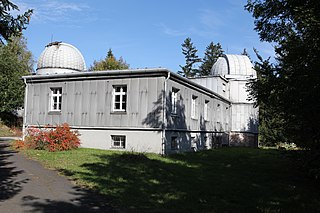
Sonneberg Observatory is an astronomical observatory located at 638 m altitude on Erbisbühl in the Neufang district of Sonneberg. The observatory was founded in 1925 on the initiative of Cuno Hoffmeister by the town of Sonneberg with the support of the Carl-Zeiss-Stiftung. The observatory carries out long-term studies of variable stars. To this end the sky is monitored continuously through photography, resulting in one of the largest archives of astronomical plates. The observatory was also always engaged in popularising astronomy, which now continues in the Astronomy Museum on site.

The Royal Observatory of Belgium has been situated in the Uccle municipality of Brussels since 1890.

Richard Reinhard Emil Schorr, was a German astronomer who served as the director of the Hamburger Stemwarte at the end of the 19th century.

The Archenhold Observatory was named in honour of Friedrich Simon Archenhold, is an observatory in Berlin-Treptow. It houses the Großer Refraktor, which is the longest pointable telescope in the world. It is also called Die Himmelskanone.

Leibniz Institute for Astrophysics Potsdam (AIP) is a German research institute. It is the successor of the Berlin Observatory founded in 1700 and of the Astrophysical Observatory Potsdam (AOP) founded in 1874. The latter was the world's first observatory to emphasize explicitly the research area of astrophysics. The AIP was founded in 1992, in a re-structuring following the German reunification.

Urania Sternwarte is a public observatory in the Lindenhof quarter of Zürich, Switzerland. Its name Urania refers to the muse of astronomy in Greek mythology.
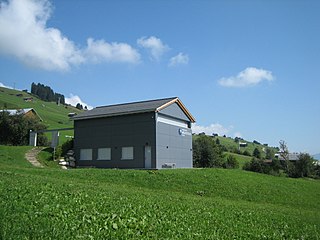
The Mirasteilas Observatory is an astronomical observatory in Falera in the canton of Grisons in Switzerland. With its 90-centimeter telescope it is the largest publicly accessible observatory in Switzerland.

Great refractor refers to a large telescope with a lens, usually the largest refractor at an observatory with an equatorial mount. The preeminence and success of this style in observational astronomy defines an era in modern telescopy in the 19th and early 20th century. Great refractors were large refracting telescopes using achromatic lenses. They were often the largest in the world, or largest in a region. Despite typical designs having smaller apertures than reflectors, great refractors offered a number of advantages and were popular for astronomy. It was also popular to exhibit large refractors at international exhibits, and examples of this include the Trophy Telescope at the 1851 Great Exhibition, and the Yerkes Great Refractor at the 1893 World's Fair in Chicago.
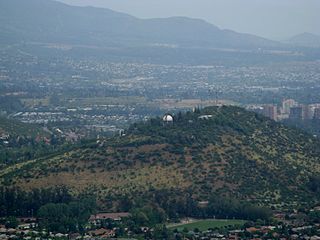
The National Astronomical Observatory of Chile is an astronomical observatory owned and operated by the Department of Astronomy of the University of Chile (UCh). It is located on Cerro Calán, a hill in the commune of Las Condes. The commune is an eastern suburb of Santiago located in Santiago Province of the Santiago Metropolitan Region. OAN was founded in 1852 and became a part of UCh in 1927. The facility on Cerro Calán was completed in 1962.

The Altona Observatory was an astronomical observatory situated in the Palmaille, in Altona, Hamburg. The observatory was founded by Heinrich Christian Schumacher in 1823 and continued to operate until 1871, 21 years after his death. It closed due to funding being cut off following the cession of the 'Elbe Duchies' of Schleswig, Holstein, and Saxe-Lauenburg by Denmark to Austria and Prussia following the Second Schleswig War.

Potsdam Great Refractor is an historic astronomical telescope in an observatory in Potsdam, Germany.

The Wilhelm Foerster Observatory in Berlin is a large public observatory which allows visitors to observe the sky through several telescopes. The facility is named after the German astronomer Wilhelm Foerster.
